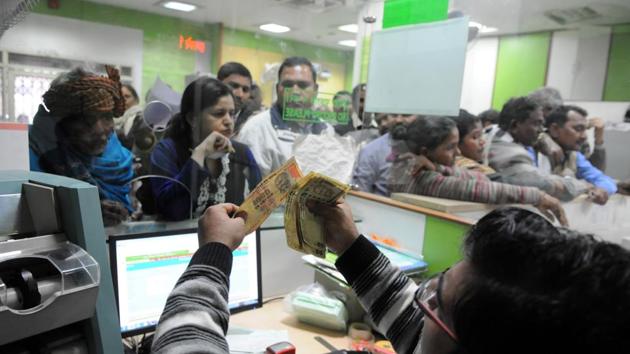India’s banking system, warts and all, remains a safe bet
Using the learnings from the demonetisation (and remonetisation) exercise to reform the banking system is a good idea. Blaming bankers, a not so good one.
India’s bankers, especially those who work at State-owned banks which dominate the industry, are not happy.

Since November 8, when Prime Minister Narendra Modi announced the invalidation of high-value currency notes, and their replacement with new ones, with assorted (and ever-changing) conditionalities and constraints, they have been hard at work, sometimes even over weekends.
They have handled irate customers, even had to deal with angry mobs and put up with instances of vandalism and threats of bodily harm.
Read: Are bankers India’s new corrupt?
Initially feted for their service by customers, and even Modi himself, bankers found the narrative changing with time as the queues continued, investigative agencies unearthed money-laundering rackets involving some bankers, and it emerged that almost all of the Rs 15.4 trillion in circulation in old Rs 500 and Rs 1,000 notes before November 8 may be deposited in banks by the deadline of December 30.
Bloomberg reported on January 4, citing people it didn’t name, that Rs 14.97 trillion of the banks had been deposited in banks by December 30.
The government had originally hoped that between Rs 2.5 trillion and Rs 5 trillion of the amount would not find its way back to banks because it was unaccounted (or black) money.
There are three possible explanations for this: There was no black money; not all black money was in the form of cash (and, in fact, only very little was); people with black money found ingenious ways to get the money into the system.
The first is unlikely, the second, plausible, and the third, even more so (especially because someone needs to take the blame for the arithmetic not working out).
Read: Axis Bank’s Shikha Sharma says embarrassed over handful of employees
There are enough anecdotes doing the rounds on the various methods of money laundering that people have used since November 8. Everyone seems to know someone who knows someone else that can get this done. One such involves the use of mules. Another, people who exchange black money at a discount and have the means to show this as legitimate income. Some of these methods involve corrupt and complicit bankers.
That narrative has stuck.
Bankers, already being blamed for the pile-up of bad loans in the system, believe this is the unkindest cut.
Over the past two years, as India’s banking system has come under tremendous stress on account of bad and under-performing loans, bankers have increasingly come under scrutiny. But not all loans were made because of extraneous considerations, including political pressure. Some of these loans turned bad because the projects they were made against ran into trouble because of non-availability of land or fuel. Others turned bad on account of rank mismanagement by the companies. And in still other cases, banks loaned money imprudently in the pursuit of aggressive growth.
Although the Central Bureau of Investigation (CBI) has launched a few dozen probes into what it terms “suspicious” loans, there’s little to show that the problem is widespread.
Read: Bank Board chief Vinod Rai hints at major overhaul in the banking system
This time around, CBI and the Enforcement Directorate have arrested some bankers for helping launder money, but, again, there’s no evidence that the problem is systemic. Indeed, a back-of-the-envelope calculation based on the numbers available show that the alleged laundering is likely to have happened in less than 1% of the money deposited with banks. And even that may turn out to be an aggressive estimate.
If the narrative is different, blame it on everyone’s desire to find an answer to the original question: Where is the black money (at least the portion of it that was held in cash)?
If the narrative is different, also blame it on the fact that the opportunity for venality at banks has gone from “wholesale to retail,” as Mint pointed out in a December 28 article provocatively headlined: Are bankers India’s new corrupt?
Read: Note ban most disruptive policy innovation since 1991: D. Subbarao
Where bad loans are involved, the opportunity for corruption in banks is at the higher levels of management. Where exchange or deposit of old currency notes is involved, there is an opportunity at much lower levels of management.
That doesn’t necessarily mean the opportunity was tapped, which explains the angst among bankers.
The Indian banking system is dominated by State-owned banks. Over the past decade or so, they have seen their staff strength being depleted – there’s an unofficial employment freeze on – and have also found themselves unable to attract the best talent, which has gravitated towards private banks that offer far more attractive remuneration. Even chairpersons of state-owned bank do not earn much. As Mint pointed out in 2016, “At Rs.31.1 lakh, the (annual) salary of Arundhati Bhattacharya, chairperson of State Bank of India, India’s largest bank, pales in comparison with that of Shikha Sharma of Axis Bank who took home Rs.5.5 crore.” Then, there’s the issue of government interference, although (and I have taken this at face value), several bank chairmen have told me that this is far less now than it was in the past.
Still, India’s banking system, warts and all, remains safer and better run than banking systems in many other countries.
Using the learnings from the demonetisation (and remonetisation) exercise to reform the banking system is a good idea. Blaming bankers, a not so good one.
R Sukumar is editor, Mint





